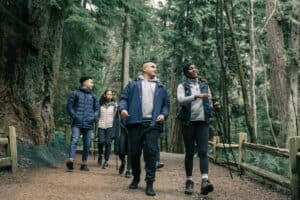Trail running is a captivating, versatile sport that offers benefits to people of all age groups. Blending the natural environment with physical activity, trail running elevates routine running into an enchanting outdoor experience. It forges a unique combination of increased strength, improved running performance, and an opportunity to connect with nature. Through variated terrains, trail running offers the ability to test your body at different levels and become a more efficient runner.
Adapting Trail Running for Various Age Groups: Understanding Your Age Group

Age is a crucial factor that influences an athlete’s trail running performance. Understanding the physiological response of different age groups helps in creating a personalized trail running schedule. This understanding aids trail runners in strategizing their training plan, focusing on maintaining optimum running pace and predicting trail running performance. As you age, your oxygen uptake capacities, energy expenditure, running speed, and recovery time may change, this understanding immensely affects the training tips given to different age groups.
Adapting Trail Running for Children
Engaging children in trail running is a fantastic way to spark an early interest in physical activity. It can be more fun compared to road running as the varying terrains and natural settings offer a play-like environment. Protection and proper guidance are key factors when it comes to kids participating in trail running. Following safety measures like slower pace on downhill running, investing in technical trails according to skill level, and ensuring hydration at aid stations can provide a safe environment for children.
Adapting Trail Running for Teenagers

As teenagers are at a crucial stage of physical growth, trail running can be a great medium for their overall physical development. The hormone surge in this age group can be well-addressed with the hard workouts trail running offers. Teenagers should aim to maintain an easy effort initially and gradually build up speed. Pacing is not to be ignored; keeping a watch on the heart rate can be beneficial.
Adapting Trail Running for Adults
The primary focus for adults should be to build endurance and maintain a consistent running pace to enhance running economy. Adults generally have fully grown bodies, and trail running can offer them an opportunity to push their physical limits and improve overall performance. They can work towards practicing running on flat terrain for faster pace and even include cross training for overall strength and speed.
Adapting Trail Running for Seniors
For senior citizens, trail running can be a fantastic way to stay active. Seniors might require additional focus on strength training techniques that can avoid injury and ensure safety. Seniors may also need to pay attention to the recovery time, and appropriate level of intensity while running, trail running can bring a seamless combination of health and adventure in their life.
General Tips for Adapting Trail Running to any Age Group
Regardless of the age group, there are a few trail running essentials that every trail runner must follow, be it warming up exercises before you hit the trail, wearing appropriate running shoes, setting a realistic training plan, or hydrating enough. These are common elements to ensure that the trail run is safe and efficient.
Overcoming Challenges across Age Groups in Trail Running

Various challenges can arise across different age groups while trail running. These challenges might range from mastering technical terrains for new runners, ensuring a faster pace for experienced runners, to maintaining cardiovascular health for senior runners. Understanding these challenges can help in formulating precise training tips and strategies for each age group.
Building Stamina for Trail Races
Stamina plays a vital role for all trail runners. It determines how well a runner can maintain their running speed and endurance across longer distances and varying terrains. A strategically designed training plan, including tempo runs, speed work, and strength training, can assist trail runners in enhancing their stamina for trail races.
Preparation for Race Day
Preparing for a race is much different than casual trail running. Race preparation requires runners to focus on several factors like determining the race pace, familiarizing oneself with the race course and its technical aspects, preparing for unexpected hurdles like weather changes, and maintaining proper sleep and food regimes.
Training the Mind along with the Body
Trail running is not just a test of physical capabilities but also a challenge for mental endurance. Many runners experience a state of mental exhaustion during the trail race, which can affect their overall running performance. Techniques like mindfulness, meditation, and concentration exercises can help in building mental strength alongside physical fitness.
Understanding the Roll of Laboratory Exercise Tests
Advancements in sports physiology have made it possible to measure and predict running performance using laboratory exercise tests. These tests measure factors such as oxygen uptake, heart rate, and lactate threshold, providing valuable insights into an athlete’s bodily functions and capacity.
Mixing It Up: The Benefits of Cross Training
Cross-training is an excellent way to stay active and fit while giving your trail running muscles a break. Engaging in activities like swimming, cycling, or strength training allows you to work on different muscle groups, reducing the risk of overuse injuries, and also keeping the training regimen engaging.
How to Pace Your Run
Controlling your pace helps in enhancing running performance and maintaining energy throughout the run. It’s crucial not just to start running at a high speed but maintain a consistent pace that can be upheld across the entire distance. Factors like heart rate, perceived exertion, and race day tempo play an essential role in efficient pacing strategies.
The Role of Nutrition in Boosting Performance

A runner’s diet significantly impacts their performance. Eating balanced meals with adequate carbs, proteins, and fats ensures the body functions efficiently. Good nutrition also aids in faster recovery post-runs and prolonged energy during the run.
Understanding Different Types of Trails
Each trail presents its distinct challenges – from flat terrain to steep inclines, technical terrains with obstacles, and downhill running areas. Knowledge of different types of trails enables runners to prepare accordingly and adapt their skills to various running conditions, thereby helping them become more versatile and efficient runners.
Trail Running Tips for Beginners
If you’re new to trail running, it can be an exciting yet challenging endeavor. Adapting to the trails and optimizing your performance requires some know-how. Here are some tips to help beginners like you get started on the right foot:
- Gradually build up your mileage: Start with shorter distances and gradually increase your mileage over time. This will allow your body to adapt to the demands of trail running and reduce the risk of injury.
- Invest in proper gear: Get yourself a good pair of trail running shoes that offer traction and stability on various terrains. Additionally, consider wearing moisture-wicking clothing to stay comfortable during your runs.
- Learn downhill running techniques: Downhill sections can be challenging for beginners, so practice proper technique. Lean slightly forward and let gravity work for you while maintaining control through shorter strides.
- Incorporate cross-training: Strengthening muscles used in trail running is crucial for injury prevention and improved performance. Include strength training exercises, such as lunges, squats, and core workouts, in your routine.
- Focus on efficient form: Pay attention to your posture while running – keep your head up, shoulders relaxed, and arms swinging naturally by your sides. Strive for a smooth stride that minimizes energy expenditure.
- Follow a structured training plan: A well-designed training plan will help you progress safely and effectively as a trail runner. It should include a mix of easy runs, tempo runs, speed work, long runs, and rest days for optimal fitness development.
Remember that trail running is more than just physical exertion; it’s about enjoying nature and challenging yourself mentally as well. Embrace the beauty of technical trails or relish the simplicity of flat terrain – every run offers unique experiences!
Safety Precautions for Trail Runners
When it comes to trail running, safety should always be a top priority regardless of your age group. To ensure a safe and enjoyable experience on the trails, here are some important safety precautions to keep in mind:
- Know the trail: Before heading out, familiarize yourself with the trail you’ll be running on. Check for any potential hazards such as steep inclines, technical terrain, or slippery sections.
- Wear appropriate gear: Invest in proper trail running shoes that provide good traction and support. Dress in moisture-wicking clothing and consider wearing layers to adapt to changing weather conditions.
- Stay hydrated: Bring enough water or hydration fluids to stay properly hydrated throughout your run. Consider using a hydration pack or belt for easy access.
- Tell someone your plans: Always let someone know where you’ll be running and when you expect to return. It’s essential for someone to have this information in case of an emergency.
- Carry essentials: Pack a small first aid kit with basic supplies like band-aids, blister pads, and antiseptic wipes. Additionally, carry a whistle for signaling help if needed.
- Be aware of wildlife: In certain areas, it’s important to be mindful of wildlife encounters such as snakes or bears. Research local guidelines and take necessary precautions like making noise while running to avoid surprising animals.
- Monitor weather conditions: Keep an eye on weather forecasts before hitting the trails and during your run if possible. Be prepared for sudden changes in temperature or severe weather events by carrying extra layers.
- Buddy system: Whenever possible, run with a friend or join a running group for added safety and socialization benefits.
- Listen to your body: Pay attention to any signs of fatigue, pain, or discomfort during your run. Take breaks when needed and don’t push yourself beyond your limits.
- Respect trail etiquette: Be courteous to other trail users, yield to hikers or bikers when necessary, and follow any posted rules or regulations.
Final Thoughts: Adapting Trail Running for Various Age Groups
The beauty of trail running lies in its adaptability across various age groups. With proper guidance, safety measures, and a conscious understanding of one’s body, anyone can enjoy this activity. Whether it is your first mile, or you are hitting the trail for a faster running speed to break the course record, trail running welcomes all. No matter your age or athletic ability, trail running has a place for anyone who wishes to experience the thrilling blend of nature and sports.
Bringing multiple factors into play—from your heart rate training to considerations on lactate threshold and perceived exertion—trail running accommodates every fitness journey. Hence, trail running can introduce a sense of adventure into staying fit, whether you are running for fun, preparing for trail races, or looking to break your race time. In essence, trail running has an all-encompassing, far-reaching potential in the world of fitness that welcomes all with open arms.
